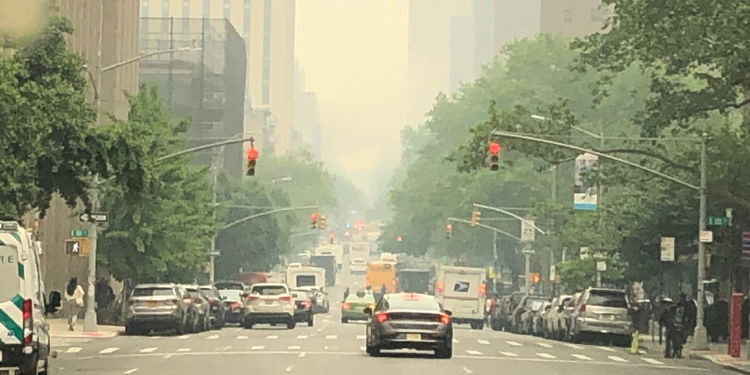
Last week, some countries in Northern Europe experienced smoke originating from numerous wildfires in Canada, following its widespread coverage over provinces and extensive regions of the United States earlier in the week. Although the dense smoke gradually diminished over the northeast during the past few days, the fires continued to present a significant hazard.
Wildfires in Canada: What is the current situation?
According to the Canadian Interagency Forest Fire Centre, the number of active fires in Canada has reached 450, with a new fire reported last week. This represents an increase from the count of 417 fires recorded nationwide on Friday, June 9.
The center's daily updated map reveals that these fires are spreading across the country, stretching from one coast to the other. The provinces in eastern and western Canada are experiencing a significant concentration of fires, affecting both the East and West Coasts.
A Filipino expat residing in Winnipeg posted on June 14: “Here's the sun this afternoon, and a few minutes ago, it's completely covered of haze due to the wildfires in our neighboring province of Alberta. The air quality had dropped down due to the haze, and it smells so bad”. She accompanied the post with a picture of a red sun drowning in grey smog.
How did the wildfires start?
According to Reuters, the wildfires in Quebec were caused by lightning — in fact, lightning is responsible for 50 % of wildfires in the country.
The cause of the wildfires in Alberta is still unknown. However, the fires in other parts of the country are attributed to human activity: for instance, passengers throwing cigarette butts from moving trains.
A number of Canadian residents have taken to social media, calling for others to be more careful with fire, especially in hot summer months, with one Facebook user posting: “We are blanketed again with smoke from wildfires. The sun is hazy, as is the sky. Just a reminder, if you do want to have a bonfire, take care to check if conditions allow and always have a water source to put a fire out when done.”
How wildfires in Canada are affecting other countries
While the wildfires in Canada have not spread to the neighboring United States, their environmental impact is felt far beyond the Canadian borders.
On the morning of June 8, a dense blanket of wildfire smoke swept into northern Minnesota, leading to a significant decline in air quality that reached Code Red levels. This classification indicates hazardous conditions for the general public.
As the day progressed, the thick smoke traveled further south, engulfing Minneapolis and pushing its local air quality to nearly unprecedented levels. Air quality alerts extended across the majority of Minnesota and Wisconsin for at least several days.
Washington D.C., Philadelphia, and New York were also grappling with their most severe air quality in years. The smog resulted in the cancellation of school outings and sporting events, including the White House's planned pride celebrations in the capital. The National Zoo also had to close its doors, ensuring the safety of its animals, including three giant pandas who were moved indoors for shelter.
Even smaller towns in the New York area, like Syracuse, were affected: meetups and bike rides were canceled. Josephine, an American and a former expat in China says that she never expected to see such high air pollution levels in her native town of Syracuse: “When we had our daughter, we made the decision to move back home from Shanghai because we were worried about the pollution levels in the city.” Shanghai is known for poor air quality levels caused by coal combustion, industrial dust and motor vehicles. “I was sure that I wouldn't have to worry about the quality of air in our town — but we are back to wearing Pm 2.5 masks, just like in Shanghai”.
In nearby Baltimore, residents were seen wearing masks as they carried out their daily activities. According to the U.S. Environmental Protection, the cities in North America suffered the worst air pollution on June 8. At this time, the air quality in cities like Washington, D.C., Philadelphia, and New York was substantially worse than in the cities of Lahore (Pakistan) and Dhaka (Bangladesh), known for their hazardous air pollution levels.
But the United States is not the only country affected by smoke from the wildfires in Canada. Over the past few days, billowing columns of smoke have extended their reach from Canada, traversing across Greenland and Iceland, ultimately reaching the shores of Norway.
International air travel has also been disrupted. On June 8, FlightAware reported a minimum of 437 flight delays at LaGuardia and a minimum of 211 delays at Newark Liberty airports. In response to the wildfires, certain airlines, such as United and American Airlines, provide waivers enabling affected passengers to reschedule their flights without incurring any extra charges.
Are the wildfires now under control?
The Canadian government has recently released an updated assessment regarding the wildfire season in the country. Typically spanning from May to October, this year's wildfire season has already been classified as "severe" according to the most recent outlook published this week. The report issued a warning stating that ongoing drought conditions and long-term forecasts of warm temperatures indicate the potential for consistently high fire activity throughout most parts of Canada during the 2023 wildland fire season.
Given the circumstances, Canada has elevated its preparedness level to "national preparedness level 5," signifying that all national resources have been mobilized to combat wildfires across the country.
If you are planning to travel to Canada or the United States in the near future, it's recommended that you follow wildfire updates to be aware of any flight disruptions and air pollution situations. The following resources can help:
Canadian Wildland Fire Information System (interactive map)
AirNow (air quality index)



















